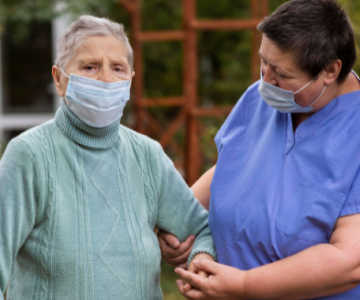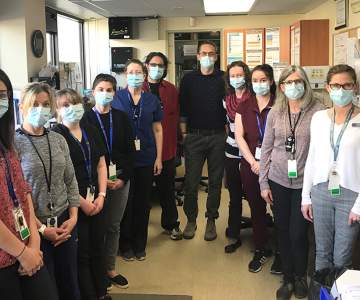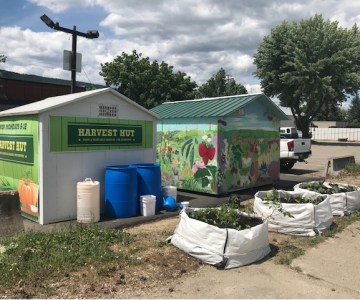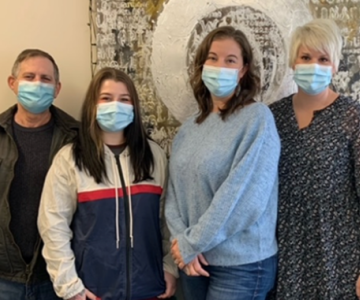Breadcrumb
Explore Stories
Health & Wellness
Housing is both a basic need and a human right. And yet, many people in the Interior Health region are without homes.
The reasons behind why someone may become homeless are complex, interconnected and are no fault of the individual. In fact, homelessness can happen to anyone – and the stigma associated with not having a home can create barriers to healthy living opportunities for those who are experiencing homelessness.
“Having a home is a basis for everything. Without it, it’s impossible to do anything … all you can do is survive,” says Shane, a resident at a Vernon supportive housing facility featured in a recent BC Housing video. “The general public considers us dirty and bad. And like, everybody’s a criminal, and that’s not the case.”
People without homes are constantly experiencing stigma, prejudice and discrimination. Terms such as “bum” and even labels such as “homeless person” dehumanize the person behind the situation and takes away from individual identity. Negative stereotypes and stigma increase the shame and embarrassment of people living without homes; this, in turn, creates barriers to seeking help and further perpetuates poor health outcomes. Using non-stigmatizing language can help.
Individuals living without housing are often in survival mode, trying to meet very real life-or-death needs like securing food to eat, finding a safe place to sleep and trying to stay out of the elements. People experiencing homelessness often have poorer physical and mental health outcomes, including high rates of infectious and chronic disease, severe mental illness, and premature death.
Having access to good quality, accessible, appropriate and affordable housing can support the health and well-being of individuals and communities. For example, access to affordable housing can reduce stress and allow people to take better care of themselves and their families by having more disposable income. More disposable income then allows people to spend money on healthy food, medication, recreational opportunities, and educational opportunities which, in turn, can help reduce health inequities.
As resident Jill says in the BC Housing video: “I don’t know that I’d ever be able to be who I am, and who I want to be … if I wouldn’t have had a place to live.”
Healthy housing contributes to a sense of safety, greater social well-being and improved quality of life.
Learn more:
Health & Housing Infographic _Page 1 (interiorhealth.ca)
Substance Use & Addiction Services | Health & Wellness | IH (interiorhealth.ca)
BC Housing video – My Place Supportive Housing in Vernon BC
BC Housing Podcast
Community & Culture
Name: Janet Quesnel (she/her/hers)Job Title: Registered Nurse Years of Service: 35Worksite: Ashcroft Hospital & Health CentreCommunity: AshcroftAncestral Territory: Nlaka’pamuxAdvice to live by: Treat others as you expect to be treated, and respect others as you expect them to respect you.
Hailing from Edinburgh, Scotland, Janet Quesnel immigrated in 1966 to Wabush, Labrador. She made her B.C. debut with a move to Logan Lake in 1972 and has been in Ashcroft since 1987. A registered nurse (RN), Janet has been with Interior Health for 35 years.
Research & Innovation
Nurse Simomo Ndebele says both patients & health-care professionals will benefit from the new Phil & Jennie Gaglardi Tower at Royal Inland Hospital in Kamloops.
A new era for the Royal Inland Hospital (RIH) in Kamloops will begin in July when a vision that has been in the works for years comes to reality with a massive capital investment in the region: the opening of the Phil & Jennie Gaglardi Tower at RIH. The new nine-storey hospital will continue to modernize the RIH campus, building on the opening of the Clinical Services Building in 2016.
During the design and construction of the Gaglardi Tower, health-care professionals were able to provide input into the design to ensure staff and physician working conditions were considered and to put patient care at the forefront. RIH registered psychiatric nurse Simomo Ndebele, known as Mo around the hospital, was one of the people who made the Gaglardi Tower a made-in-Kamloops-for-Kamloops design.
Health & Wellness
When my frail elderly aunt had a fall at home, she was admitted to Penticton Regional Hospital emergency department for assessment. The care team listened to our concerns and worked with us to figure out how best to assess her, because we knew her best and understood what her usual behaviours and abilities were.
Later in the day, the physician contacted us to explain the assessment, interventions and follow up and then asked my husband, “how do you feel about taking her home?”
I was really impressed with the question and relieved to know we weren't just going to be told she was being discharged.
While my aunt was in their care that day, the care team had built a relationship of trust and we were happy to bring her home knowing the team had assessed her carefully and planned for what interventions would be necessary for her to go home.
Recent research shows there is a strong connection between how well you plan for someone to be sent home (discharged) from the hospital, and the likelihood that they will need to go back to the hospital (readmitted). This is especially true for older people.
Team-based care (like the kind my aunt received) stresses the importance of including family as valued members of the health-care team, particularly when planning for a person to leave the hospital. Team-based care also focuses on communicating openly with patients and families to balance the caregiver’s needs and expectations with the discharge process offered by the facility.
Want to learn more? Check out our information on Getting discharged from hospital.
About the author:
Mary Kjorven is a gerontologist and works with Interior Health as a regional clinical nurse specialist
Community & Culture
Kootenay Boundary Regional Hospital team
The pharmacy team at Interior Health is constantly striving to be at the leading edge of health care through innovation, progression and dedication.
Whether a staff pharmacist, clinical pharmacist, pharmacy assistant or pharmacy technician, they are all part of a larger team that has been built on the foundation of support and collaboration.
Health & Wellness
Have you ever thought about ways to enhance our food systems for a healthier tomorrow? At Interior Health (IH), public health dietitians work with communities to increase food security, support food literacy and strengthen local food systems.
Health & Wellness
Members of the Kamloops Integrated Treatment Team are providing a new model of flexible, discreet and person-centred substance use treatment. Left to right: Loyd Suel, Avery Foster, Shawna Calhoun and Jen Howes.
Addiction is a highly stigmatized medical condition and people may be worried about how friends, family and employers will respond. For example, they may not want to be seen at a Mental Health and Substance Use centre. They may be worried about asking their employer for time off work. Or, they may be juggling a busy schedule caring for children or other family members.
Fortunately there is a new, flexible and discreet option for those interested in treatment for substance use in their community. Integrated Treatment Teams are now available in Kamloops, North Okanagan, Penticton, West Kelowna, and Cranbrook.
Community & Culture
Name: Randine Mariona (she/her/hers)Job Title: Mental Health & Substance Use ClinicianYears of Service: 11 yearsWorksite: North Shore Health Science CentreCommunity: KamloopsAncestral Territory: Tk’emlúps te Secwe̓pemcAdvice to live by: “What lies behind you and what lies in front of you, pales in comparison to what lies inside of you.” - Ralph Waldo Emerson
For Randine, Mental Health & Substance Use Clinician, every day is an opportunity to hear people's stories, and validate their courage and strength. She loves nothing more than to celebrate small steps they take to recover, heal and integrate their lived experiences into a model that highlights their resilience. This is what inspires her in her work as a social worker.
Research & Innovation
All nursing roles share the same end goal of caring for the health of people.
Nursing informatics is the practice and science of integrating nursing information and knowledge with technology in order to enhance health-care delivery. This benefits patients and their families, as digital health technologies enable health-care teams to provide quality care in an accessible way.
Allison Chow made the switch from outpatient nursing to nursing informatics in virtual care. She was drawn to this field of work as she recognized her nursing background aligned with her natural aptitude for, and interest in, digital technology.
A day in the life of a nursing informatics specialist brings the opportunity to collaborate with other health-care teams to enhance workflow delivery and streamline applications.
This work includes creating resources to empower health-care providers with practices to deliver effective patient-centered virtual visits. She reviews the ever-changing climate of digital health and collaborates towards making sure virtual care data is presented in a standard format and language.
She works with a variety of clinical and technical teams, including mentoring co-operative students to foster learning and promote future growth within the organization. She collaborates with other government organizations to improve access to interpreters and closed captioning for those with limited English proficiency or who are deaf, deaf-blind, or hard of hearing.
Interior Health is a large region often requiring patients to travel extensively to see their health-care providers. Virtual Care enables more flexible options and convenience when accessing care.
Interested in exploring career options at Interior Health? Check out Careers@IH
-
Load More
Showing 495 of 796
Sign up for email updates
Receive news, alerts, public service announcements and articles right to your inbox.










